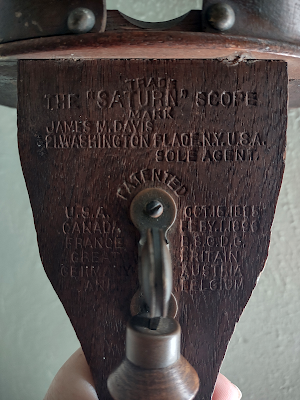A friend asked me to explain on my blog how I view all these 3D pictures, so here is a post about that. First, here's a picture of my real, old-fashioned stereoscope. This particular one is marked on the bottom that it's a "Saturn" Scope, with patent dates of October 15, 1895 and February 1, 1896. It's a version of the Holmes stereoscope, which was invented in 1861 by Oliver Wendell Holmes, Sr. and deliberately not patented. Mine is missing a little piece of wood at the end of the part that divides the two views, so I've attached a bit of paperboard so each eye doesn't see the edge of the opposite view. Paper stereograph cards--the one shown here is the original of the last recolor I blogged about--sit in a holder that slides backward and forward to focus. Unfortunately it's easy to slide it all the way off, and therefore a lot of stereoscopes end up for sale without it. I have a second stereoscope that came in an eBay lot with this one, but it's missing both the card holder and the handle. I haven't yet tried to restore that one, beyond popping the glass lenses back in after they got knocked out during shipping.
Anyway, the general idea is that if you have two pictures taken from about as far apart as the distance between our eyes, you can show each picture to the correct eye and your brain will register the combination as a 3D object instead of a flat one. The first stereoscope, designed by Charles Wheaton in 1838, was a complicated affair involving mirrors and hand-drawn images. With the development of photography and the invention of the cheaper Holmes stereoscope, though, the technique became an extremely popular form of home entertainment. So many paper stereo cards were produced that a large number survived and are still available today. Prices vary wildly, and if you want something specific you might be in for a long search, but as antiques go they're quite accessible.
It's not always convenient to get out a fragile, antique device, and the stereoscope needs good lighting. So more often I use this handy little modern gadget to view digital copies on my smartphone. Any headset compatible with the unfortunately discontinued Google Cardboard works, but I prefer this minimalist version I got on Amazon for $6.99. Here's a link to it; it's not an affiliate link or anything, I just haven't found anything cheaper or more effective. The product description doesn't make a lot of sense, but judging from the reviews I'm not the only one who likes it for viewing stereographs. To use it, just load the picture on a phone in landscape mode (turn on auto rotate) and clip the viewer right on the line between the two sides. Hold it by the phone and not by the viewer so as not to knock it out of alignment, and look into the lenses as if they were a pair of binoculars. Since this model has open sides, it's easy to swipe from one picture to the next. You can also zoom in and out to focus if necessary. And it folds up to about the size of your palm, so it's portable, too. I've had more than enough fun out of mine to justify the price, so I definitely recommend getting one of your own.




No comments:
Post a Comment